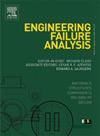A study on crankshaft failure in diesel engine of wheel loader
IF 4.4
2区 工程技术
Q1 ENGINEERING, MECHANICAL
引用次数: 0
Abstract
Crankshafts are essential parts within internal combustion engines are prone to fatigue failure due to cyclic loading. This paper investigates the failure in a six-cylinder diesel engine crankshaft from a wheel loader, which exhibited an unusual fracture pattern. Unlike common failures where cracks initiate at the crankpin fillet and propagate toward the main journal, this crack originated at the fifth crankpin fillet and terminated at its center. Various analyses were conducted to determine the root cause of failure, including chemical composition testing, microstructural examination, mechanical testing, scanning electron microscopy of the fracture surface, and finite element analysis of stress distribution. The results indicated that a reduction in molybdenum content, low hardness, and inclusions MnS contributed to reduced fatigue resistance. Additionally, the structural stress assessment revealed that the greatest stress concentration occurred at the fillet of the crankpin, corresponding to the crack initiation site. Moreover, features such as beachmarks and striations on fracture surface indicate fatigue. This study provides new insights into influence of material properties and microstructure on heavy-duty crankshaft fatigue behavior, offering recommendations for improved design and manufacturing to enhance fatigue resistance and durability.
轮式装载机柴油机曲轴失效研究
曲轴是内燃机的重要部件,在循环载荷作用下容易发生疲劳失效。本文研究了一台轮式装载机的六缸柴油机曲轴的故障,曲轴呈现出一种不寻常的断裂模式。与常见的裂纹从曲柄圆角处开始并向主轴颈扩散的故障不同,这种裂纹起源于第五个曲柄圆角,并在其中心终止。为了确定失效的根本原因,我们进行了各种分析,包括化学成分测试、显微组织检查、力学测试、断口扫描电镜以及应力分布的有限元分析。结果表明,钼含量的降低、硬度的降低和夹杂物的MnS降低了合金的抗疲劳性能。此外,结构应力评估表明,最大应力集中发生在曲销圆角处,与裂纹起裂部位相对应。此外,断口表面的滩痕和条纹等特征表明疲劳。该研究为材料性能和微观结构对重型曲轴疲劳行为的影响提供了新的见解,为改进设计和制造提供了建议,以提高抗疲劳性和耐久性。
本文章由计算机程序翻译,如有差异,请以英文原文为准。
求助全文
约1分钟内获得全文
求助全文
来源期刊

Engineering Failure Analysis
工程技术-材料科学:表征与测试
CiteScore
7.70
自引率
20.00%
发文量
956
审稿时长
47 days
期刊介绍:
Engineering Failure Analysis publishes research papers describing the analysis of engineering failures and related studies.
Papers relating to the structure, properties and behaviour of engineering materials are encouraged, particularly those which also involve the detailed application of materials parameters to problems in engineering structures, components and design. In addition to the area of materials engineering, the interacting fields of mechanical, manufacturing, aeronautical, civil, chemical, corrosion and design engineering are considered relevant. Activity should be directed at analysing engineering failures and carrying out research to help reduce the incidences of failures and to extend the operating horizons of engineering materials.
Emphasis is placed on the mechanical properties of materials and their behaviour when influenced by structure, process and environment. Metallic, polymeric, ceramic and natural materials are all included and the application of these materials to real engineering situations should be emphasised. The use of a case-study based approach is also encouraged.
Engineering Failure Analysis provides essential reference material and critical feedback into the design process thereby contributing to the prevention of engineering failures in the future. All submissions will be subject to peer review from leading experts in the field.
 求助内容:
求助内容: 应助结果提醒方式:
应助结果提醒方式:


